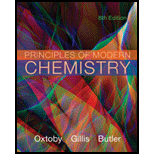
Bundle: Principles of Modern Chemistry, 8th + OWLv2, 1 term (6 months) Printed Access Card
8th Edition
ISBN: 9781305705456
Author: OXTOBY, David W., Gillis, H. Pat, Butler, Laurie J.
Publisher: Cengage Learning
expand_more
expand_more
format_list_bulleted
Question
Chapter 1, Problem 19P
Interpretation Introduction
Interpretation: The relative atomic mass of B-11 isotope of boron needs to be determined.
Concept Introduction: Isotope is defined as atoms of same element with same
The
Here, %A is percentage
Expert Solution & Answer
Want to see the full answer?
Check out a sample textbook solution
Students have asked these similar questions
Show work with explanation needed....don't give Ai generated solution
1.
6. Draw the products for the following reaction:
2.
Diels-Aider
reaction
NOH O
OH
3.
4.
Chapter 1 Solutions
Bundle: Principles of Modern Chemistry, 8th + OWLv2, 1 term (6 months) Printed Access Card
Ch. 1 - Classify the following materials as substances or...Ch. 1 - Classify the following materials as substances or...Ch. 1 - A 17th-century chemist wrote of the “simple bodies...Ch. 1 - Since 1800, almost 200 sincere but erroneous...Ch. 1 - A sample of ascorbic acid (vitamin C) is...Ch. 1 - A sample of a compound synthesized and purified in...Ch. 1 - Nitrogen (N) and silicon (Si) form two binary...Ch. 1 - Iodine (I) and fluorine (F) form a series of...Ch. 1 - Vanadium (V) and oxygen (O) form a series of...Ch. 1 - Prob. 10P
Ch. 1 - Prob. 11PCh. 1 - Prob. 12PCh. 1 - Pure nitrogen dioxide (NO2) forms when dinitrogen...Ch. 1 - Gaseous methanol (CH3OH) reacts with oxygen (O2)...Ch. 1 - In J. J. Thompson’s experiment depicted in Figures...Ch. 1 - In the problem 15 above, what is vy , the...Ch. 1 - The natural abundances and isotopic masses of the...Ch. 1 - The natural abundances and isotopic masses of the...Ch. 1 - Prob. 19PCh. 1 - More than half of all the atoms in naturally...Ch. 1 - The isotope of plutonium used for nuclear fission...Ch. 1 - The last “missing” element from the first six...Ch. 1 - Prob. 23PCh. 1 - In 1982, the production of a single atom of...Ch. 1 - Prob. 25PCh. 1 - Prob. 26PCh. 1 - Compute the relative molecular masses of the...Ch. 1 - Prob. 28PCh. 1 - Suppose that a person counts out gold atoms at the...Ch. 1 - A gold atom has a diameter of 2.881010m . Suppose...Ch. 1 - The vitamin A molecule has the formula C20H30O ,...Ch. 1 - Arrange the following in order of increasing mass:...Ch. 1 - Mercury is traded by the “flask,” a unit that has...Ch. 1 - Gold costs $400 per troy ounce, and...Ch. 1 - Aluminum oxide (Al2O3) occurs in nature as a...Ch. 1 - Prob. 36PCh. 1 - Soft wood chips weighing 17.2 kg are placed in an...Ch. 1 - In a reproduction of the Millikan oil-drop...Ch. 1 - A rough estimate of the radius of a nucleus is...Ch. 1 - In a neutron star, gravity causes the electrons to...Ch. 1 - Prob. 41APCh. 1 - Naturally occurring rubidium (Rb) consists of two...Ch. 1 - A sample of a gaseous binary compound of boron and...
Knowledge Booster
Similar questions
- Pleasssssseeee solve this question in cheeemsirty, thankss sirarrow_forwardPleasssssseeee solve this question in cheeemsirty, thankss sirarrow_forwardThe Ksp for lead iodide ( Pbl₂) is 1.4 × 10-8. Calculate the solubility of lead iodide in each of the following. a. water Solubility = mol/L b. 0.17 M Pb(NO3)2 Solubility = c. 0.017 M NaI mol/L Solubility = mol/Larrow_forward
- Pleasssssseeee solve this question in cheeemsirty, thankss sirarrow_forwardPleasssssseeee solve this question in cheeemsirty, thankss sirarrow_forwardOnly 100% sure experts solve it correct complete solutions need to get full marks it's my quiz okkkk.take your time but solve full accurate okkk chemistry expert solve itarrow_forward
arrow_back_ios
SEE MORE QUESTIONS
arrow_forward_ios
Recommended textbooks for you
 Chemistry: The Molecular ScienceChemistryISBN:9781285199047Author:John W. Moore, Conrad L. StanitskiPublisher:Cengage Learning
Chemistry: The Molecular ScienceChemistryISBN:9781285199047Author:John W. Moore, Conrad L. StanitskiPublisher:Cengage Learning Chemistry & Chemical ReactivityChemistryISBN:9781337399074Author:John C. Kotz, Paul M. Treichel, John Townsend, David TreichelPublisher:Cengage Learning
Chemistry & Chemical ReactivityChemistryISBN:9781337399074Author:John C. Kotz, Paul M. Treichel, John Townsend, David TreichelPublisher:Cengage Learning Chemistry for Engineering StudentsChemistryISBN:9781337398909Author:Lawrence S. Brown, Tom HolmePublisher:Cengage Learning
Chemistry for Engineering StudentsChemistryISBN:9781337398909Author:Lawrence S. Brown, Tom HolmePublisher:Cengage Learning Chemistry for Today: General, Organic, and Bioche...ChemistryISBN:9781305960060Author:Spencer L. Seager, Michael R. Slabaugh, Maren S. HansenPublisher:Cengage Learning
Chemistry for Today: General, Organic, and Bioche...ChemistryISBN:9781305960060Author:Spencer L. Seager, Michael R. Slabaugh, Maren S. HansenPublisher:Cengage Learning Chemistry & Chemical ReactivityChemistryISBN:9781133949640Author:John C. Kotz, Paul M. Treichel, John Townsend, David TreichelPublisher:Cengage Learning
Chemistry & Chemical ReactivityChemistryISBN:9781133949640Author:John C. Kotz, Paul M. Treichel, John Townsend, David TreichelPublisher:Cengage Learning

Chemistry: The Molecular Science
Chemistry
ISBN:9781285199047
Author:John W. Moore, Conrad L. Stanitski
Publisher:Cengage Learning

Chemistry & Chemical Reactivity
Chemistry
ISBN:9781337399074
Author:John C. Kotz, Paul M. Treichel, John Townsend, David Treichel
Publisher:Cengage Learning

Chemistry for Engineering Students
Chemistry
ISBN:9781337398909
Author:Lawrence S. Brown, Tom Holme
Publisher:Cengage Learning

Chemistry for Today: General, Organic, and Bioche...
Chemistry
ISBN:9781305960060
Author:Spencer L. Seager, Michael R. Slabaugh, Maren S. Hansen
Publisher:Cengage Learning

Chemistry & Chemical Reactivity
Chemistry
ISBN:9781133949640
Author:John C. Kotz, Paul M. Treichel, John Townsend, David Treichel
Publisher:Cengage Learning
